AMD Ryzen 9 5980HS Cezanne Review: Ryzen 5000 Mobile Tested
by Dr. Ian Cutress on January 26, 2021 9:00 AM EST- Posted in
- CPUs
- AMD
- Vega
- Ryzen
- Zen 3
- Renoir
- Notebook
- Ryzen 9 5980HS
- Ryzen 5000 Mobile
- Cezanne
CPU Tests: Rendering
Rendering tests, compared to others, are often a little more simple to digest and automate. All the tests put out some sort of score or time, usually in an obtainable way that makes it fairly easy to extract. These tests are some of the most strenuous in our list, due to the highly threaded nature of rendering and ray-tracing, and can draw a lot of power. If a system is not properly configured to deal with the thermal requirements of the processor, the rendering benchmarks is where it would show most easily as the frequency drops over a sustained period of time. Most benchmarks in this case are re-run several times, and the key to this is having an appropriate idle/wait time between benchmarks to allow for temperatures to normalize from the last test.
Blender 2.83 LTS: Link
One of the popular tools for rendering is Blender, with it being a public open source project that anyone in the animation industry can get involved in. This extends to conferences, use in films and VR, with a dedicated Blender Institute, and everything you might expect from a professional software package (except perhaps a professional grade support package). With it being open-source, studios can customize it in as many ways as they need to get the results they require. It ends up being a big optimization target for both Intel and AMD in this regard.
For benchmarking purposes, we fell back to one rendering a frame from a detailed project. Most reviews, as we have done in the past, focus on one of the classic Blender renders, known as BMW_27. It can take anywhere from a few minutes to almost an hour on a regular system. However now that Blender has moved onto a Long Term Support model (LTS) with the latest 2.83 release, we decided to go for something different.
We use this scene, called PartyTug at 6AM by Ian Hubert, which is the official image of Blender 2.83. It is 44.3 MB in size, and uses some of the more modern compute properties of Blender. As it is more complex than the BMW scene, but uses different aspects of the compute model, time to process is roughly similar to before. We loop the scene for at least 10 minutes, taking the average time of the completions taken. Blender offers a command-line tool for batch commands, and we redirect the output into a text file.

Intel loses out here due to core count, but AMD shows a small but not inconsequential uplift in performance generation-on-generation.
Corona 1.3: Link
Corona is billed as a popular high-performance photorealistic rendering engine for 3ds Max, with development for Cinema 4D support as well. In order to promote the software, the developers produced a downloadable benchmark on the 1.3 version of the software, with a ray-traced scene involving a military vehicle and a lot of foliage. The software does multiple passes, calculating the scene, geometry, preconditioning and rendering, with performance measured in the time to finish the benchmark (the official metric used on their website) or in rays per second (the metric we use to offer a more linear scale).
The standard benchmark provided by Corona is interface driven: the scene is calculated and displayed in front of the user, with the ability to upload the result to their online database. We got in contact with the developers, who provided us with a non-interface version that allowed for command-line entry and retrieval of the results very easily. We loop around the benchmark five times, waiting 60 seconds between each, and taking an overall average. The time to run this benchmark can be around 10 minutes on a Core i9, up to over an hour on a quad-core 2014 AMD processor or dual-core Pentium.
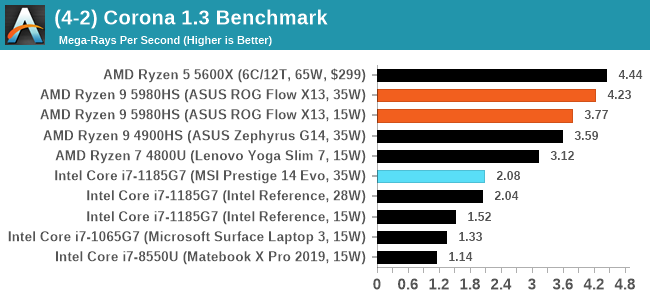
Corona shows a big uplift for Cezanne compared to Renoir.
Crysis CPU-Only Gameplay
One of the most oft used memes in computer gaming is ‘Can It Run Crysis?’. The original 2007 game, built in the Crytek engine by Crytek, was heralded as a computationally complex title for the hardware at the time and several years after, suggesting that a user needed graphics hardware from the future in order to run it. Fast forward over a decade, and the game runs fairly easily on modern GPUs.
But can we also apply the same concept to pure CPU rendering? Can a CPU, on its own, render Crysis? Since 64 core processors entered the market, one can dream. So we built a benchmark to see whether the hardware can.
For this test, we’re running Crysis’ own GPU benchmark, but in CPU render mode.

At these resolutions we're seeing a small uplift for Cezanne. We spotted a performance issue when running our 320x200 test where Cezanne scores relatively low (20 FPS vs Renoir at 30 FPS), and so we're investigating that performance issue.
POV-Ray 3.7.1: Link
A long time benchmark staple, POV-Ray is another rendering program that is well known to load up every single thread in a system, regardless of cache and memory levels. After a long period of POV-Ray 3.7 being the latest official release, when AMD launched Ryzen the POV-Ray codebase suddenly saw a range of activity from both AMD and Intel, knowing that the software (with the built-in benchmark) would be an optimization tool for the hardware.
We had to stick a flag in the sand when it came to selecting the version that was fair to both AMD and Intel, and still relevant to end-users. Version 3.7.1 fixes a significant bug in the early 2017 code that was advised against in both Intel and AMD manuals regarding to write-after-read, leading to a nice performance boost.
The benchmark can take over 20 minutes on a slow system with few cores, or around a minute or two on a fast system, or seconds with a dual high-core count EPYC. Because POV-Ray draws a large amount of power and current, it is important to make sure the cooling is sufficient here and the system stays in its high-power state. Using a motherboard with a poor power-delivery and low airflow could create an issue that won’t be obvious in some CPU positioning if the power limit only causes a 100 MHz drop as it changes P-states.
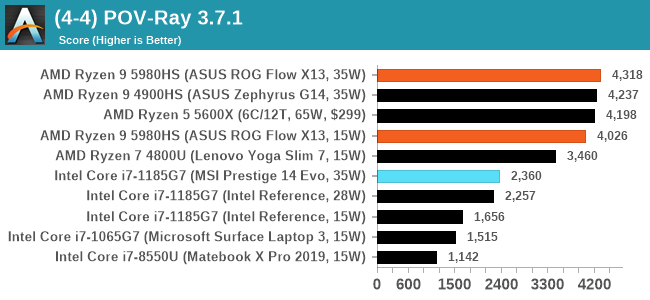
V-Ray: Link
We have a couple of renderers and ray tracers in our suite already, however V-Ray’s benchmark came through for a requested benchmark enough for us to roll it into our suite. Built by ChaosGroup, V-Ray is a 3D rendering package compatible with a number of popular commercial imaging applications, such as 3ds Max, Maya, Undreal, Cinema 4D, and Blender.
We run the standard standalone benchmark application, but in an automated fashion to pull out the result in the form of kilosamples/second. We run the test six times and take an average of the valid results.
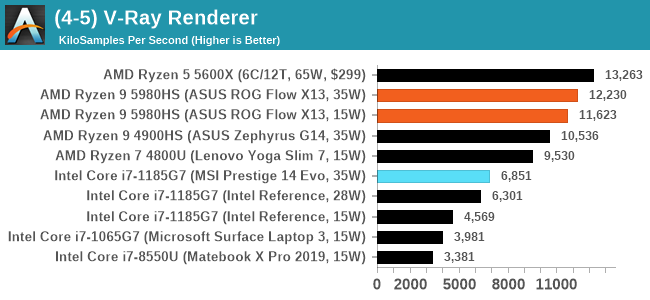
Another good bump in performance here for Cezanne.
Cinebench R20: Link
Another common stable of a benchmark suite is Cinebench. Based on Cinema4D, Cinebench is a purpose built benchmark machine that renders a scene with both single and multi-threaded options. The scene is identical in both cases. The R20 version means that it targets Cinema 4D R20, a slightly older version of the software which is currently on version R21. Cinebench R20 was launched given that the R15 version had been out a long time, and despite the difference between the benchmark and the latest version of the software on which it is based, Cinebench results are often quoted a lot in marketing materials.
Results for Cinebench R20 are not comparable to R15 or older, because both the scene being used is different, but also the updates in the code bath. The results are output as a score from the software, which is directly proportional to the time taken. Using the benchmark flags for single CPU and multi-CPU workloads, we run the software from the command line which opens the test, runs it, and dumps the result into the console which is redirected to a text file. The test is repeated for a minimum of 10 minutes for both ST and MT, and then the runs averaged.

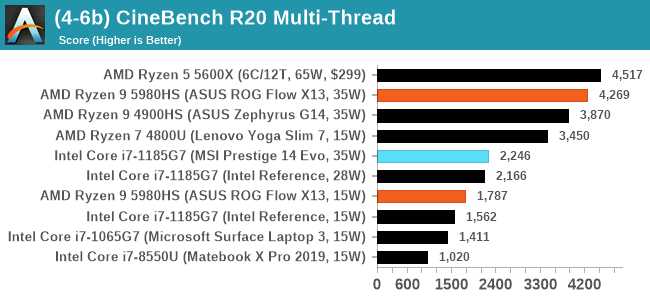
We didn't quite hit AMD's promoted performance of 600 pts here in single thread, and Intel's Tiger Lake is not far behind. In fact, our MSI Prestige 14 Evo, despite being listed as a 35W sustained processor, doesn't seem to hit the same single-core power levels that our reference design did, and as a result Intel's reference design is actually beating both MSI and ASUS in single thread. This disappears in multi-thread, but it's important to note that different laptops will have different single core power modes.



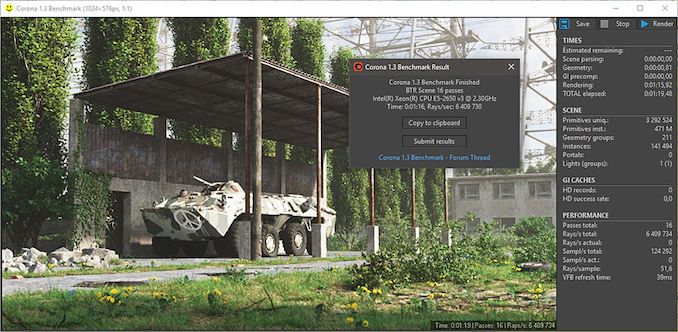
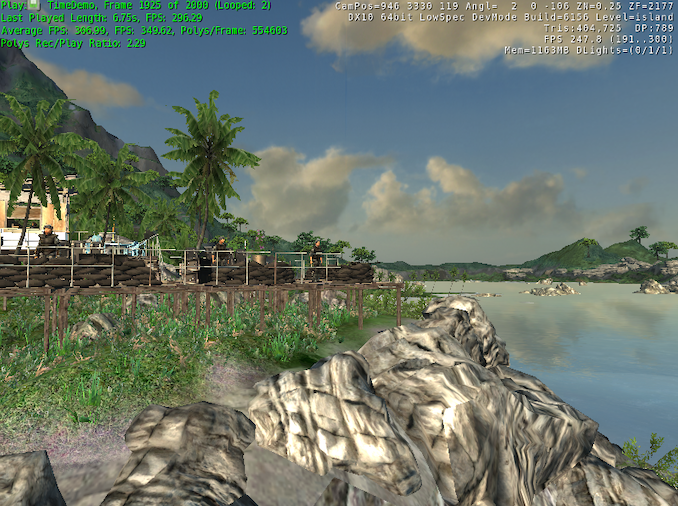











218 Comments
View All Comments
vladx - Wednesday, January 27, 2021 - link
What? Since Thunderbolt 3 has a 40Gbps bandwidth it is absolutely not "only using 4 PCIe 3.0 lanes on PCs that have Titan Ridge controllers.Spunjji - Thursday, January 28, 2021 - link
The short answer is: yes, it is.The long answer is:
https://www.techspot.com/review/2104-pcie4-vs-pcie...
Tams80 - Monday, February 1, 2021 - link
8x will be enough. It should only be a 2-3% drop in performance.Of course 16x would be nice, but I don't think OCuLink is available as that.
Fulljack - Wednesday, January 27, 2021 - link
the FP5 package used by AMD mobile processor only allows PCIe 3.0 x8 connection to dGPU, but you still have extra x4/x4 connection for I/O and storage.when moving to AM4, desktop Renoir still have the same PCIe lanes as Matisse, that is 16+4+4 lanes.
it's not a problem since TB3 eGPU are using PCIe 3.0 x4 anyway.
nils_ - Wednesday, January 27, 2021 - link
I was wondering about that as well, it also seems a bit confusing with Tiger Lake (is it 4 or 8 lanes of PCIe 4.0?). The advantage with Tiger Lake is that it has TB4 integrated in the SoC, unfortunately I haven't seen any AMD based laptop with TB so far so I went with Intel to keep my docking station(s). Maybe this time around there will be a model foregoing the dGPU for a TB controller.Spunjji - Thursday, January 28, 2021 - link
TL has 4 lanes of PCIe 4.0Spunjji - Thursday, January 28, 2021 - link
"I've been seeing reports of it only having x8 PCIe 3.0 lanes, which could present a problem to AMD's apparent goal of pairing Cezanne with discrete GPUs."Nope. See all the announced devices with Cezanne and RTX 3070 or 3080 GPUs.
It was never a problem with Renoir, either. People just came up with post-hoc rationalizations for why Intel still dominated gaming laptops despite having an inferior CPU.
ottonis - Tuesday, January 26, 2021 - link
The mobile Zen3 CPUs are a great generational update. Glad to see a healthy increase in new design wins and one can only hope that AMD will be able to deliver all these CPUs to the OEMs in sufficient quantities so these notebooks will be available to the consumer.That being said, the true challenge is Apple Silicon. While AMD can beat the M1 CPU in multi core tasks, Apple will outclass everything x86 once they introduce their second gen silicon with much higher core count and other architectural improvements.
So, I wonder what kind of strategy AMD (and Intel) will follow in the near future. I remember - maybe ~10+y ago - when AMD had some sort of transient partnership with ARM and everybody thought AMD would somehow implement ARM designs into some sort of hybride chip. For some reasons that never came to fruition.
In order to stay relevant in the mobile (and desktop) CPU market, AMD will have to react to the huge attack from Apple silicon in one way or another. So, what does AMD have up their sleeves?
Intel is apparently going the big.little route in their next generation of mobile CPUs with little Atom-based cores and big performance cores. I am curious what AMD is up to.
JfromImaginstuff - Tuesday, January 26, 2021 - link
Well about AMD's relationship with arm, they have an arm license, so does Intel for that matter. So if x86 starts going south, AMD will almost certainly abandon it, and Intel most likely will do so as well especially with their new CEO.Deicidium369 - Wednesday, January 27, 2021 - link
LOL - Gelsinger's great grand kids will be on Social Security before that happens